TARA Technical Overview
Contents
- Introduction
- UHECRs and Extensive Air Showers
- Theory of Radar Detection of Cosmic Ray Airshowers
- Results of Preliminary Studies
- Scope of Research
- The Future
- Bibliography
1 Introduction
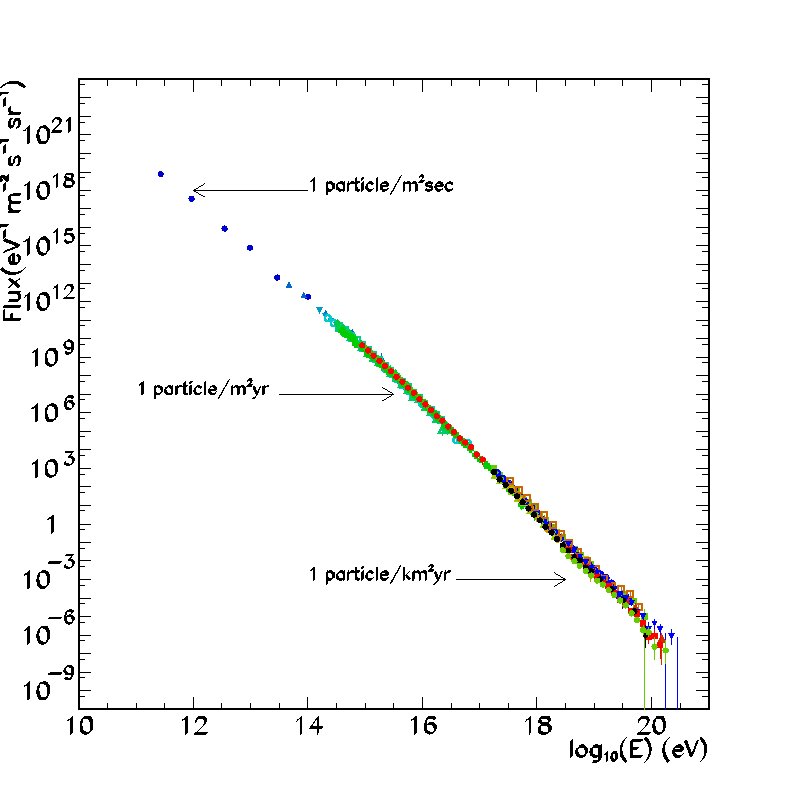
The cosmic ray all-particle spectrum.
Understanding the sources and chemical composition of the most energetic extraterrestrial radiation or "cosmic rays" is a major thrust of current astrophysical research. Particles with energies far exceeding what is believed possible through supernova shock acceleration regularly strike the Earth from within our galaxy and beyond. Understanding the origins of these particles will require accurate models of the most violent processes in the universe.
The study of high-energy cosmic rays is also increasingly a field of study requiring financial and manpower resources on a scale colloquially known as "big science". The reason for this is contained in the cosmic ray energy spectrum itself, illustrated in the figure below. The spectrum is known to basically follow a power law, in which the flux of particles incident on the Earth falls off as 1/(energy)3. Thus at the highest energies, detectors with apertures of hundreds or thousands of square kilometers are required in order to obtain reasonable event rates. For example, the two largest detectors, the Telescope Array (Utah), and the Pierre Auger Observatory (Argentina) now in operation utilize ground arrays covering 800 km2 and 3,000 km2 respectively. Absent new technologies, the costs required to build observatories at significantly higher sensitivity are prohibitive.
There is therefore a strong incentive to develop detection methods which can cover large areas of the Earth's surface without requiring the detectors themselves to physically occupy a large area. One such technique which has been pioneered at Utah is the fluorescence method, in which light from molecular deexcitations within the extensive airshower (EAS) are captured by fast ultraviolet cameras many kilometers distant. This technique is limited however in that fluorescence observations are only possible on clear, moonless nights, corresponding roughly to a 10% duty cycle. Further, atmospheric scattering and absorption of UV light limit the seeing distance of fluorescence detectors to less than about 50 km.
Recently, there has been interest in exploiting the Radio Frequency (RF) portion of the electromagnetic spectrum for this purpose. This is possible because ionization densities of the order of 1013/m3 can be reached in the shower core for an E = 1018eV primary proton. At this ionization level the plasma frequency is roughly 50 MHz (corresponding to the low-VHF) in which range reflection will occur. Provided backgrounds are sufficiently low, EAS ionization is detectable using radar techniques to capture reflected RF radiation. This technique can be used 24 hours a day, in a sufficiently radio-quiet environment.
We seek to advance the radar technique by making use of analog television transmitters donated to the University of Utah by Salt Lake City's KUTV Channel 2 and ABC4. We have built a transmitter station at the Millard County Cosmic Ray center in Delta, Utah. This transmitter station, operating under FCC Station License WF2XHR, illuminates the sky above the Telescope Array surface detectors with a continuous 54.1 MHz carrier signal. Currently (November 2011) we broadcast at 1.5 kW, but will shortly be upgrading our transmitter to at least 40 kW. The primary science goal of TARA (see map in the figure below) is the simultaneous detection of cosmic ray airshowers by conventional and radar techniques. The sample of events thereby detected will facilitate further study of radar models as well as enable understanding of energy thresholds and geometrical resolutions.
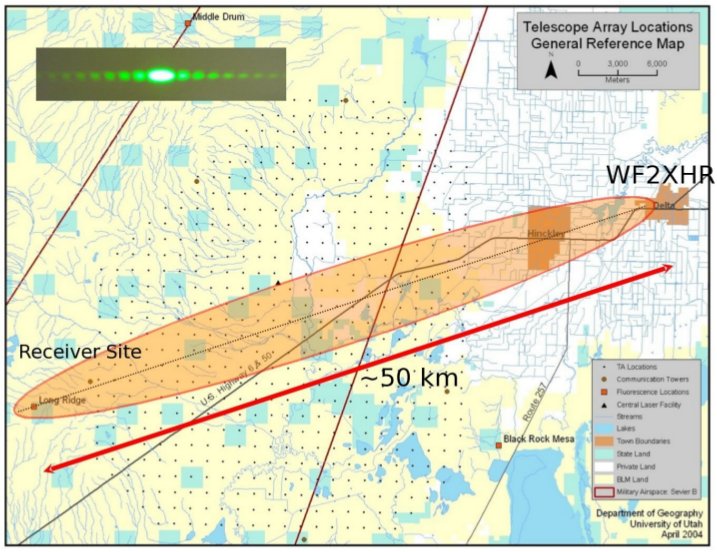
Map of the Telescope Array (TA) and TA RAdar (TARA) projects. Station WF2XHR broadcasts a 54.1 MHz carrier signal from Delta, Utah, towards the TARA receiver station at Long Ridge, 50 kilometers distant. The cigar-shaped region shows the locus of events for which the received echo will fall in the first diffractive maximum (inset, upper left) and hence result in the most readily detectable echoes.
2 UHECRs and Extensive Air Showers
Our current picture of EAS began with the work of Heitler (Heitler 1954) who first formalized a model for development of electromagnetic cascades. Photons undergo e+e- pair production, while electrons and positrons emit bremsstrahlung photons, resulting in 2n secondary particles at each of the n generations of shower development. This process will continue until the average energy of the leptons drops below the critical energy, below which energy lost to collisional processes exceeds bremsstrahlung energy losses. The depth in the cascade at which this occurs is known as shower maximum, typically expressed as Xmax.
More complete models exist which include the effects of the primary hadronic interaction present in actual air showers (Matthews 2005), and there is a small industry devoted to detailed Monte Carlo simulations of airshowers (Heck 1998). But the oversimplified picture of Heitler still predicts two important features of electromagnetic cascades, namely that the total number of particles at shower maximum Xmax is directly proportional to the energy of the primary particle, and the depth of mean Xmax is logarithmically proportional to the energy of the primary particle.
The figure below shows the most recent mean Xmax results obtained through analysis of stereoscopic data collected by the High Resolution Fly's Eye (HiRes) (Abbasi 2010). From these data we can predict the location of the densest part of the shower, which at 1019eV will be located approximately 3 kilometers above ground level for the Telescope Array surface detectors. This height will be important in radar experiment design considerations to be discussed below.
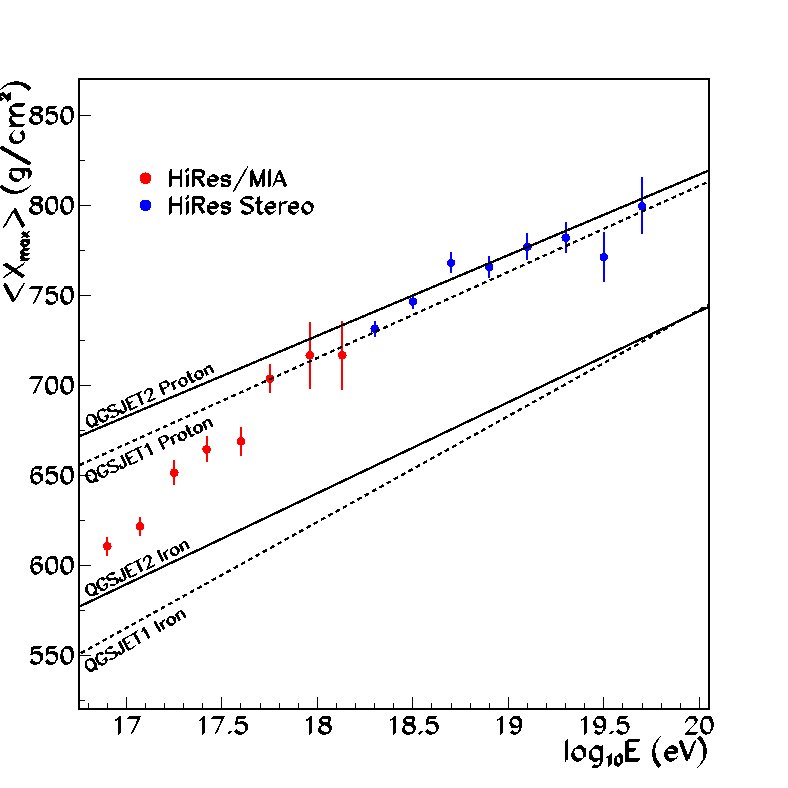
Recent HiRes results (Abbasi 2010) on depth of mean shower maximum Xmax, compared with the predictions of CORSIKA (Heck 1998) using the QGSJET1 and QGSJET2 high-energy hadronic models. A mean Xmax of 770 g/cm2 at 1019 eV translates to a mean height above ground at Telescope Array altitudes of approximately 3 kilometers.
Modern observatories studying Ultra-High Energy Cosmic Rays (UHECR) primarily make use of two technologies. Both of these technologies rely on making indirect inferences about the nature of the primary cosmic ray by observation of the EAS which the primary cosmic ray triggers in the atmosphere. The surface detector technique makes use of scintillator or Cherenkov detectors to directly observe those shower particles which arrive at the ground. The fluorescence technique traces the full development of the shower via the nitrogen fluorescence excited by the charged particles in the shower.
The surface detector technique, while directly detecting shower particles, suffers from several shortcomings. Surface detectors are only sensitive to particles striking the ground. Full reconstruction of air showers including such parameters as primary energy and Xmax relies on model-dependent assumptions about the showers themselves. Finally, the sensitivity of a surface detector is ultimately limited by the area of the Earth's surface which it is financially and practically feasible to instrument.
The nitrogen fluorescence technique directly addresses these shortcomings. The full shower development is observed in fluorescence light, which is known to be proportional to the energy deposited by the shower (Belz 2006). Thus there is minimal model dependence in determining the air shower energy or Xmax. Further, detection of nitrogen fluorescence is a remote sensing technique as airshowers may be observed from distances approaching 50 km. A major drawback to fluorescence detection is that it can only be employed on clear moonless nights, resulting in a duty factor of approximately 10%.
Over the past several years, new techniques have also begun exploiting the Radio Frequency (RF) emissions of EAS with ground arrays consisting of radio receivers sensitive to downward directed emissions (Riviere 2009, Schroeder 2009, Singh 2009). These arrays however face many of the same drawbacks as more traditional ground arrays, particularly in that they still require the full aperture on the ground to be instrumented. The radar detection of UHECR-induced EAS however has promise as a remote sensing technique without the inherent limitations of a 10% duty cycle. In the sections which follow, we outline the physics behind this technique, the results of preliminary feasibility studies and a plan for full development of the radar technique in conjunction with the Telescope Array observatory in Millard County, Utah.
3 Theory of Radar Detection of Cosmic Ray Airshowers
The concept of radar detection of EAS was introduced in the early 1940's by Blackett and Lovell (Blackett 1940) and has been revisited over the years (Suga 1962, Gorham 2001). Conceptually the technique is simple. Particles with energy larger than 1017eV produce large primary ionization densities that would scatter electromagnetic waves up to frequencies of approximately 100 MHz, permitting their detection.
This technique is upon first consideration quite similar to the radar detection of meteors (Lovell 1948, Greenhow 1952, Brown 1962) and one can use this fact as a starting point in understanding the radar response of cosmic ray airshowers. However, ionization produced by cosmic rays will happen at much lower altitudes than that produced by meteors. EAS typically form at less than 10 km above sea level and meteor ionization occurs at altitudes above 80 km. The lower altitudes will effect the lifetime of the ionization because of the free electron attachment to molecular oxygen. While the process itself is well known the exact value for the lifetime will depend on the kinetic energy of ionization electrons produced in the shower. At airshower altitudes below 10 km the plasma lifetime can be expected to be less than 100 ns (Vidmar 1990).
The starting point for understanding the received power PR from bistatic radar scattering is the bistatic radar equation

The most challenging factor to understand for EAS scattering is the RCS σ. In general, this factor will depend on the ionization charge density, and thus will vary as a function of time and radial distance from the core of the shower. There are two regimes to be considered, which depend on the relationship between the plasma frequency of the ionization charge
 (where ne is the electron number density in cm-3, e is the electron charge and me is the electron mass) and the sounding frequency fs. If ne exceeds the critical density nc for a given sounding frequency
(where ne is the electron number density in cm-3, e is the electron charge and me is the electron mass) and the sounding frequency fs. If ne exceeds the critical density nc for a given sounding frequency

- Underdense Regime: Most of the ionization electrons produced by an air shower populate the underdense regime. Here, the sounding wave can be considered as scattering off of individual classical electrons, thus the RCS is just the number of electrons multiplied by the Thomson scattering cross section:
 The number of ionization electrons produced by an EAS can be quite large. However within the Thomson scattering model the adverse effects of "collisional damping" - due to electron collisions with neutral nitrogen molecules - can reduce the power of the reflected signal by factors of 100,000 or more (Budden 1985, Vidmar 1990, Lovell 1993). With the transmitter power and distances planned for TARA we do not expect air shower echoes to be detectable via the Thomson scattering mechanism.
The number of ionization electrons produced by an EAS can be quite large. However within the Thomson scattering model the adverse effects of "collisional damping" - due to electron collisions with neutral nitrogen molecules - can reduce the power of the reflected signal by factors of 100,000 or more (Budden 1985, Vidmar 1990, Lovell 1993). With the transmitter power and distances planned for TARA we do not expect air shower echoes to be detectable via the Thomson scattering mechanism. - Overdense Regime: At the core of the air shower, ionization densities may exceed the critical density for the sounding radio waves. If the overdense region is large compared to the wavelength of the sounding waves (optical regime) then specular reflection can occur. As shown in the figure below however, this is not the most likely scenario for TARA.
Since the overdense region is expected to be only a few centimeters wide for low-VHF radiation, TARA expects to operate primarily in the "Rayleigh Regime" in which an extensive air shower will look like a thin wire. Within this regime the RCS should have the form
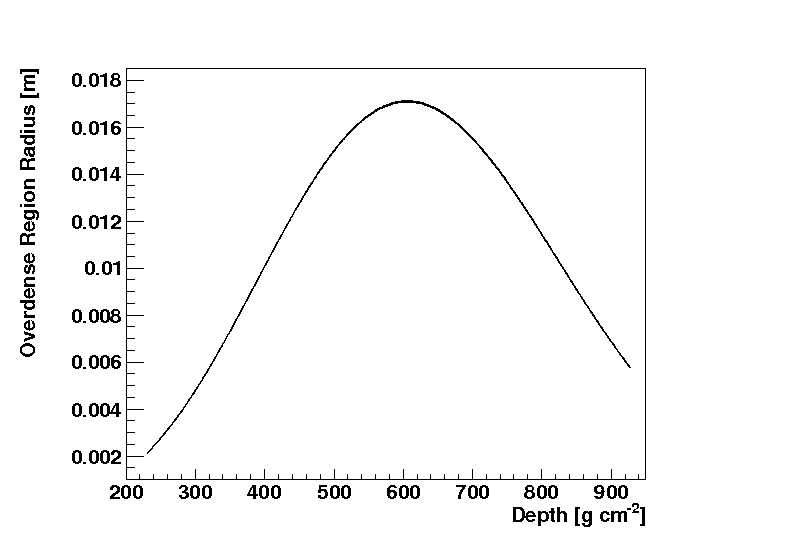
Radius of the overdense region of a 1019eV air shower, at a zenith angle of 20 degrees, as a function of depth in the atmosphere. This plot is for the case of 54.1 MHz sounding radiation, as used in TARA. Ionization densities are calculated using the Gaisser-Hillas (Gaisser 1977) air shower parametrization and the NKG (Kamata 1958, Greisen 1965) lateral density function.
 for a wire segment of length L, radius a, γ=1.78, θ is the angle between the wire and the direction of incidence and φ is the angle between the polarization direction and the plane defined by the wire and the direction of incidence (Crispin 1965).
for a wire segment of length L, radius a, γ=1.78, θ is the angle between the wire and the direction of incidence and φ is the angle between the polarization direction and the plane defined by the wire and the direction of incidence (Crispin 1965).
We estimate the received power of an airshower-reflected radio signal by treating the overdense region of the airshower as a series of segments. The estimate assumes that each wire segment will appear as the shower develops at the front and then disappear at some distance from the front because of the electron capture process. Typical lifetimes for electrons are taken from Vidmar (Vidmar 1990). As the mirror apparent position moves the receiver antenna is illuminated briefly by bursts of scattered waves that combine forming a phase-modulated signal. The resulting signal is similar to a meteor signal, albeit with a compressed time scale due to differences in formation velocity.
This calculation best done numerically, to properly account for shower directions and phase additions. Typically, we expect for the TARA setup, with a transmitter of effective radiated power 40 kW illuminating a 1019eV airshower at a zenith angle of 20 degrees, a received power as shown in the figure below.
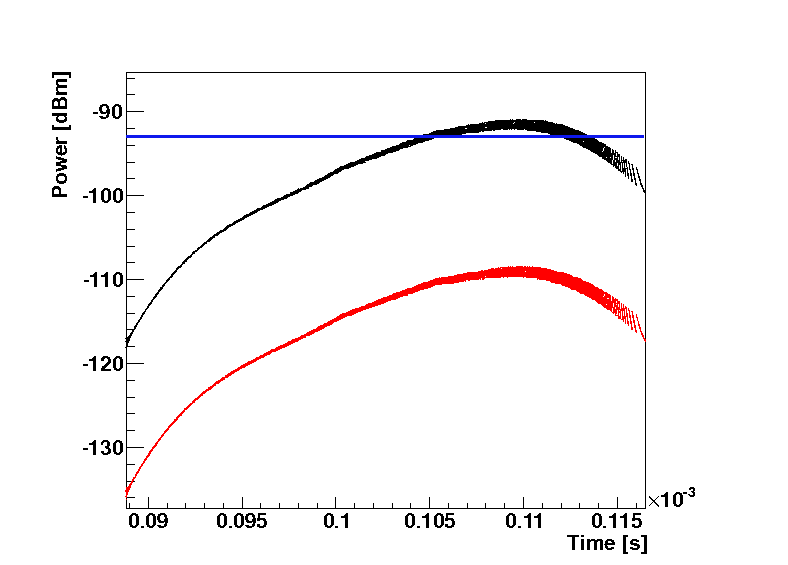
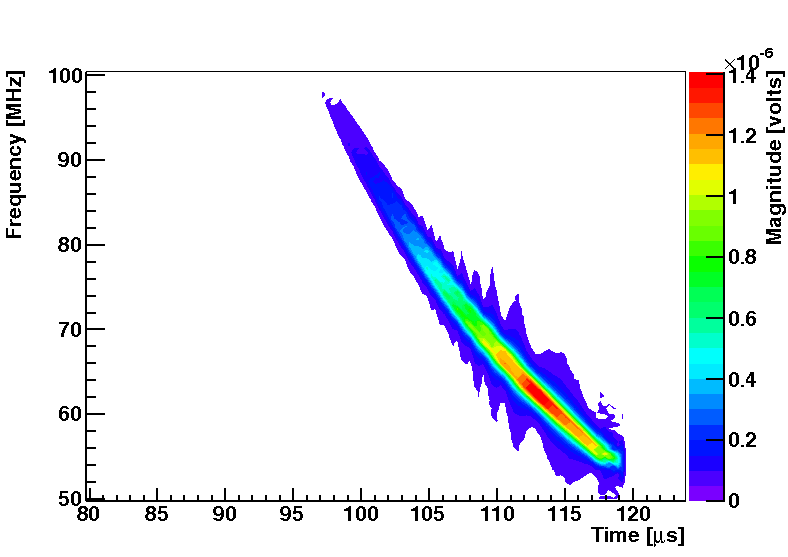
Left: Received power for reflection from overdense regime of 1019eV air shower inclined at 20 degrees from vertical. Typical TARA geometry: shower midway between transmitter and receiver 50 km distant. Black (red) curve corresponds to vertically (horizontally) polarized sounding radiation. The blue horizontal line corresponds to galactic background noise integrated over a 4 MHz bandwidth. Right: Illustration of "chirp" caused by Doppler-like phase shift of reflection from the relativistic EAS shower front, for typical TARA geometry.
As recognized by Underwood (Underwood 2008), an additional feature of the forward scattered signal will be a rapid Doppler-like frequency shift due to the phase changes of waves scattered from individual wire segments. This "chirp", like the example illustrated in the figure above, will typically appear as a frequency shift of several MHz per microsecond. While presenting challenges to the receiver system in terms of required signal bandwidth, the chirp is also a fairly unique signature which we hope will enable triggering at or below sky noise background levels in the near future.
4 Results of Preliminary Studies
In this section, we report on preliminary studies conducted in Long Island, NY and Millard County, Utah. The focus of the Long Island studies was to use commercial television signals as a radar source, along with an array of high school cosmic ray detectors, in an attempt to confirm the detection of EAS reflections with a conventional cosmic ray detector. In Utah, we aimed to characterize the radio environment of the west desert area, in order to assess its suitability for further radar studies.
4.1 Measurements in Long Island, NY
The MARIACHI experiment was set up to test the concept of using forward scattering radar for the detection of ultra high energy cosmic rays. To prove the concept, parasitic forward scattering radar stations together with 12 mini-shower detectors were set up on Long Island, NY. The key concept for the proof of principle is to detect simultaneously a radio echo and an extensive airshower by conventional means.
In radio meteor scatter it is customary to chose commercial transmitters that are of the order of 1000 km from the detection station. The most powerful stations are generally analog television (TV) stations (unfortunately these were discontinued on June 12, 2009), which provide good illumination of the skies over the Eastern United States. In particular, with the MARIACHI geometry Channel 4 analog (67.26 MHz) provided good illumination from a few kilometers above sea level to an estimated 120 km. The VHF signal propagation, especially in the low band, is a complex process that involves ground propagation and other indirect processes. We estimate that five stations contributed to the illumination at the altitudes where cosmic ray showers are present, and up to twelve stations contribute for meteor detection. The closest stations for us are in Pittsburgh, PA and Chapel Hill, NC, both with a nominal 100 kW power, of which 25% goes into the VHF carrier itself.
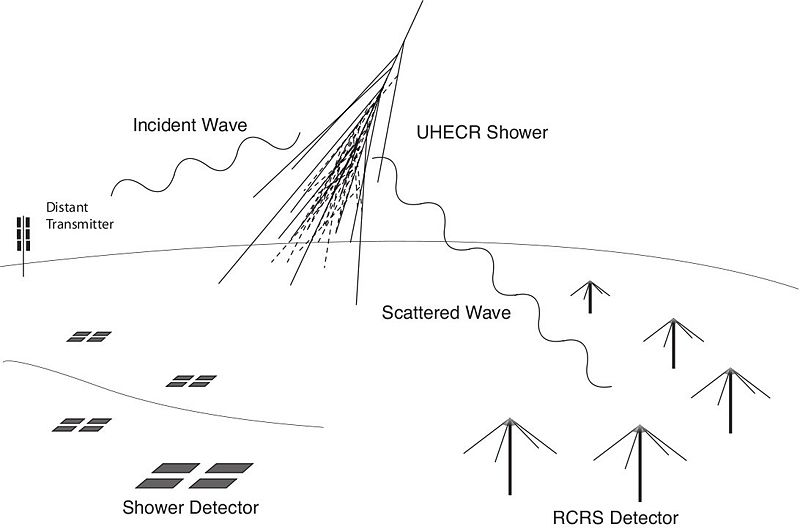
The MARIACHI experiment. Small shower detectors are used to tag the presence of showers while Radio Cosmic Ray Scattering (RCRS) stations listen to forward scattered echo. Typical distances between RCRS stations and scintillators is 40 to 80 km.
The mini shower detectors are five sets of scintillators placed at high schools, Stony Brook university and at the Selden campus of the Suffolk County Community College. When a 4-fold coincidence is detected the event time is recorded using a GPS clock. The time accuracy for the GPS clocks is 100 ns and the units purchased are specifically designed for time tagging. Each radar station is set up as in a radio meteor scatter experiment. Two inverted VEE dipoles are placed orthogonal to each other to obtain direction information, albeit with ambiguity. The antennae were tested for resonant frequency using an antenna tester and also for design impedance of 50ω. Each dipole arm is fed into a commercial narrow band PCR1000 receiver and recorded using a high end sound card. The receiver was tested for the detection of very narrow signals and was found to be sensitive down to a 5μ s pulse with considerable distortion. This distortion is observed up to signals of 50 ms width. Other radio receivers such as WinRadio G3100i that process the signal digitally were verified not to be sensitive to short signals.
The MARIACHI experiment collected data with 3 radar stations and 12 scintillator stations for a total of 8 weeks. Not all the stations were collecting data all the time and therefore there is an overall efficiency of about 50%. After the fact analysis has also shown that the data from the BNL and SCCC radar stations were noisy and although meteors could be identified, it was not possible to extract lower signals. Therefore the overall data available for analysis comprises 12 mini-shower stations and one radar station located at the Custer Institute in Southhold, NY. The radar station is located at 40 km from the closest shower station and about 70 km from the furthest. It is a location that is relatively radio quiet for Long Island but with difficult access from the point of view of data transfer that was done using large removable disks. For the analysis sequence we opted for searching for coincidence signals using the GPS timing information from the scintillators.
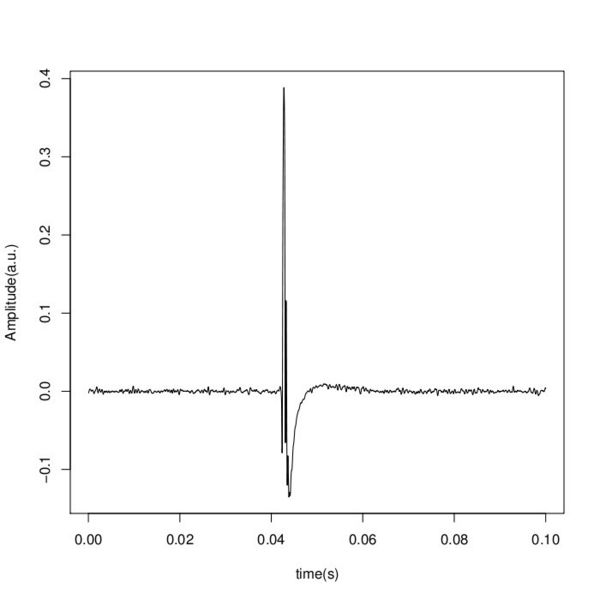
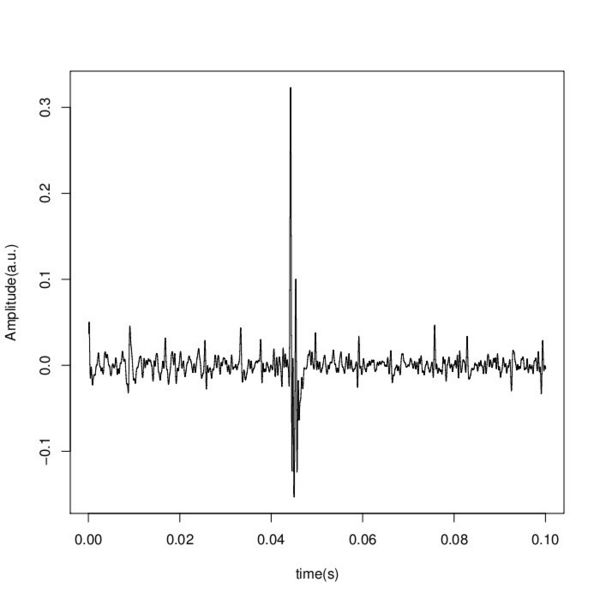
Left: Calibration signal taken with a 53 microsecond long pulse mimicking a cosmic ray signal.
Right: Cosmic ray candidate signal found in coincidence with a scintillator trigger.
The procedure to search for signals used the times given by the shower array as an offline trigger for the radar stream. To guide the pattern recognition we used an arbitrary function generator to illuminate the antenna with short signals mimicking the expected signals (figure above, left panel). We pulsed the system with signals of 5μs to 100 ms duration. This exercise allowed us to look for a specific class of signal, recognizable through their time versus frequency characteristics. With the pulser system we have also verified that our dipole system has directionality as expected for a simple dipole system. For each shower detection time a window of plus or minus 1 s was examined in the radar stream for the presence of a signal similar to those simulated by a pulser. The signal length can potentially be longer than those predicted if the lifetime values are different than those assumed. It is not expected that they will be longer than 1 ms, as that would require elevated temperatures. Therefore we accept signals that are up to 200 μs long in the searches. We have also ascertained that meteor signals are not shorter than 100 ms. From the approximately 30,000 triggers examined, the majority of the coincidences are accidental coincidences with meteor signals or anthropogenic noise. Only a small fraction (less than 1%) contain a candidate signal.
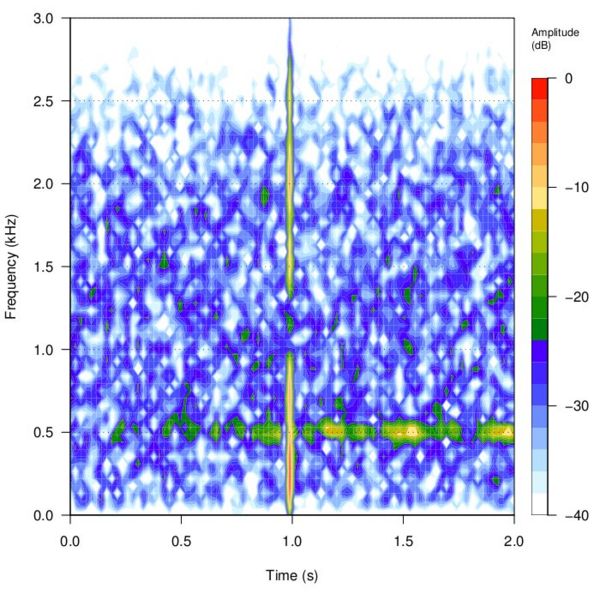
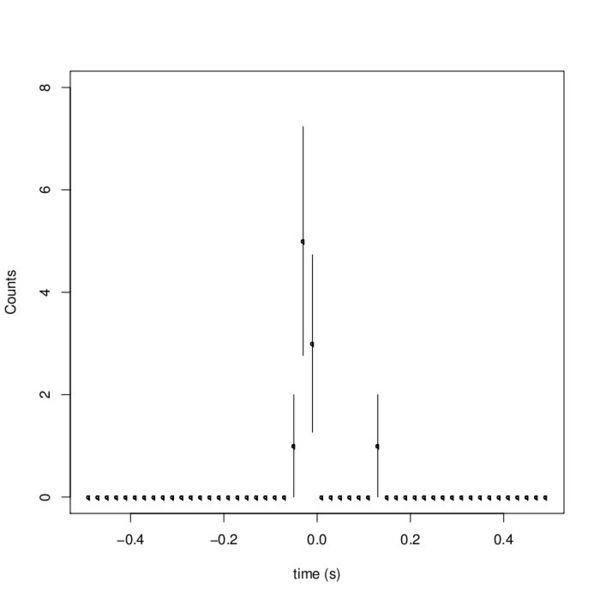
Left: Spectrogram, frequency vs time for a candidate cosmic ray signal.
Right: Histogram of events found in coincidence with the scintillator sites in a period of 2 weeks. The offset from zero is due to data acquisition timing issues.
The search for coincidences was done for a period of two weeks when the system was considered to be running at its prime. Data for other periods as mentioned above exist but a better understanding of calibration issues is required. For this analysis we chose 5 high school sites and the Custer Institute radar data stream. These schools cluster at an average distance of 60 km to the location of radar. Because the scintillator energy threshold is low, we scanned for about 30,000 triggers and found 10 events that satisfied the presence of a signal that matches the calibration signal. A typical signal found in coincidence is shown in the figure above together with a sample calibration signal. With the exception of one signal, they are all clustered (See figure above, right panel) at 50 ms prior to where the coincidence would be, i.e. at zero. This time lag is due to the data acquisition system that takes on average that amount of time to start recording data. The events found vary in duration which is translated to a characteristic frequency response. These events constitute a rate of approximately 0.7 events per day. For a threshold energy of 5*1018eV we expect a coincidence rate of approximately one per day. We hand surveyed how many cosmic ray like signals per hour we would expect, and determine that we have an accidental coincidence rate of approximately 1.8 events in the period of 2 weeks. We conclude that we have seen approximately 8 "true" coincidences between scintillator and radar.
It is possible to infer the signal bearing based on the signals observed at both dipoles with the caveat that a single dipole system does have ambiguities. The absence of stations to the east of the radar station reduces the ambiguity to two quadrants, NW and SW. Unfortunately it is difficult to eliminate either because there are equal number of stations in both. However, if one arbitrarily neglects the NW direction the estimated bearing angles of the 9 clustered events point towards the trigger scintillator station within 5 degrees. The event at Δt = +0.15 seconds was 15 degrees from the nearest scintillator station. The angle is calculated as tanθ = AEW/ANS where A is the signal amplitude in each arm. Because the antenna was aligned to the magnetic north a correction of 14o was applied to obtain the geographic bearing. This is however weak evidence and a two antenna system would be the minimal configuration for the measurement.
Albeit timing issues with the Data Acquisition System we have observed coincidences for a class of events that we classify as cosmic rays based on hardware simulated signals. The coincidences are observed between any of the 5 scintillators and the radar station at the Custer Institute that is located on average 60 km from the scintillator stations. There is also indication that the signal bearing would point towards the trigger scintillator. In spite of these evidences we are at this point unable either confirm or dismiss these events as cosmic ray echo. The fact that coincidence exists is an indication that signals were generated at the same time and it could be generated by other means, e.g. short glitches in the power grid. To pursue this research further in the urban area which profits from the abundance of TV and FM radio stations, a minimum of two radar stations would be required. At the same time careful monitoring of other electromagnetic events via e.g. VLF or direct line monitoring would be desirable. However, a better strategy is to attempt the detection of coincidences between radio echo and cosmic ray shower at a well established cosmic ray experiment such as the Telescope Array.
4.2 Measurements in Millard County, UT
Preliminary studies in Utah sought to characterize the electromagnetic noise environment in the low-VHF frequency range, in order to determine the suitability of Millard County for the development of the radar technique.
The geography of Western Utah is very different from that of the East Coast of the United States. The differences have several consequences for the types of RF studies we hope to perform. The ideal geometry for the detection of cosmic ray airshowers is one in which the atmosphere a few kilometers above ground (as stated previously, shower maximum is on average 3 km above the ground for a 1019eV shower over the Telescope Array) is illuminated by the RF source, but the receiver antennas on the ground are shielded from direct signals by mountains or the curvature of the Earth.
Long Island is situated in a relatively flat region where Earth-curvature effects dominate and there are abundant suitable RF signal sources. Millard County, Utah and the Telescope Array observatory sits at the bottom of a geographic "bowl" ringed by mountains up to and exceeding 3 km MSL. RF stations and repeaters within the bowl tend (by design) to illuminate the ground within the bowl, and hence our receiver antennas as well. Transmitters located outside the bowl illuminate the sky tens or hundreds of kilometers above ground level but not at shower maximum.
As a consequence, since the low-VHF portion of the spectrum was vacated in the analog to digital television conversion of June 2009, the skies in the vicinity of the Telescope Array are extremely radio quiet in the 50~MHz band. This point is illustrated with data we collected during summer 2009, which is shown in the figure below. A Winegard YA-6260 Broadband Yagi Antenna was pointed in an easterly direction, and its signal was read out using a Universal Software Radio Peripheral (USRP) device with a clock rate of 64 MHz. An FPGA operating as a digital down-converter (DDC) decimated the sampling by a factor of eight, corresponding to a digital bandwidth of 8 MHz being read out by PC. The USRP was set to sweep in 2 MHz steps, sampling for 10 seconds per step, and in the PC an FFT is applied to each sweep. The data is then "stitched" together to achieve the full spectrum shown.

Radio frequency background, as measured with a 6-element Yagi antenna antenna located at the Millard County Cosmic Ray Center, pointing due East. This is roughly the direction a receiver station placed at Long Ridge would face overlooking the TA surface detector. See text for measurement details. The radio skies over TA are extremely quiet in the low-VHF band, particularly since analog-to-digital switch in June 2009. "Spikes" in the background starting at approximately 88 MHz are FM radio stations. The largest, at 93.7 MHz is a 500 W translator station 71 km distant, for which line-of-sight is obscured by terrain.
With the exception of the FM radio signals (the largest is a 500 W, 93.7 MHz FM translator 71 kilometers away in Nephi, Utah which is blocked from line-of-sight by terrain) beginning at about 88 MHz, Figure 5 shows the low-VHF environment in Millard County to be very quiet, and ideally suited to radar studies with a controlled transmitter located with in Millard County, operating in this frequency regime.
5 Scope of Research
TARA is investigating the bistatic-radar detection of cosmic-ray-induced EAS with a low-VHF transmitter and receiver station in the vicinity of the Telescope Array surface detector. The current and future development of this system is described below.
5.1 Transmission Facility
The Millard County Cosmic Ray Center (CRC, figure below) is a 4,000 square foot single-story commercial building in Delta, Utah, which is owned by the University of Utah. It is the center for Telescope Array operations and data acquisition, and its considerable floor and surrounding outdoor space has been used for detector assembly, testing and repair. It is also the Telescope Array visitor center, and serves as the public face of the Telescope Array collaboration.
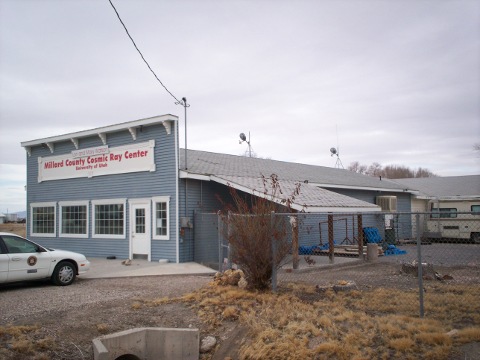
The Millard County Cosmic Ray Center (CRC).
The CRC is the location of the TARA transmitter. To date, we have commissioned a 2 kW transmitter from the Harris Platinum series. This transmitter was donated to TARA by Salt Lake City's KUTV Channel 2.
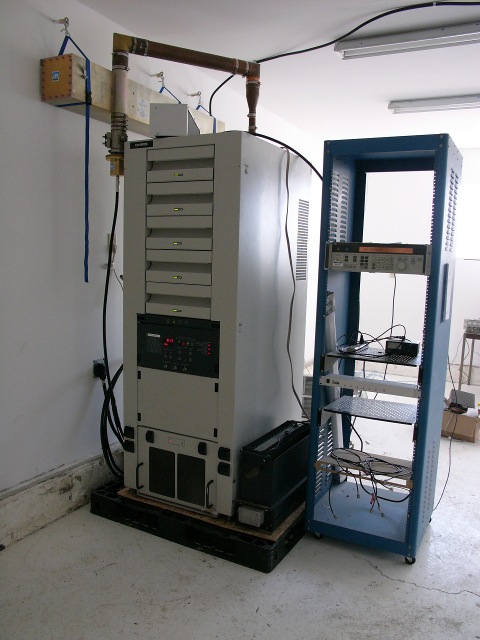
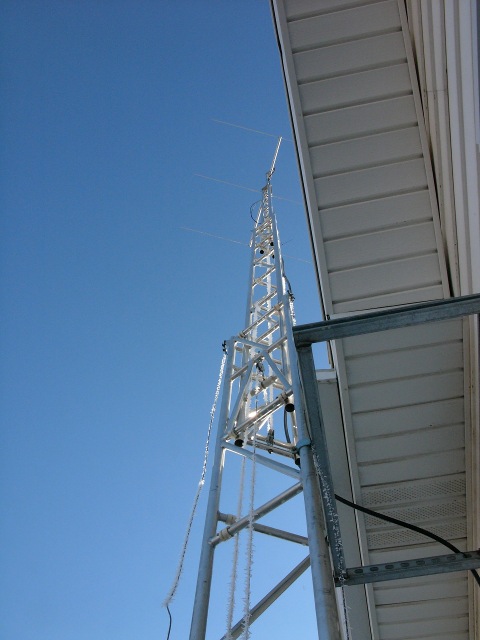
Left: 2 kilowatt transmitter in operation at the CRC, broadcasting at 54.1 MHz under FCC station license WF2XHR.
Right: 3-element Yagi transmission antenna, directing the TARA sounding waves in the direction of the Long Ridge receiver station.
Plans are underway to increase the total transmitted power by a factor of 20, using a pair of 20 kW transmitters donated to TARA by Salt Lake City television stations KUTV-2 and ABC4. In addition, the effective power of the transmitter will also be boosted by use of a high-gain (factor of 100 over isotropic) transmitting antenna. The RF signal will be piped via waveguide to the antenna, which will be attached to a 60 foot tall mast located in a field behind the CRC.
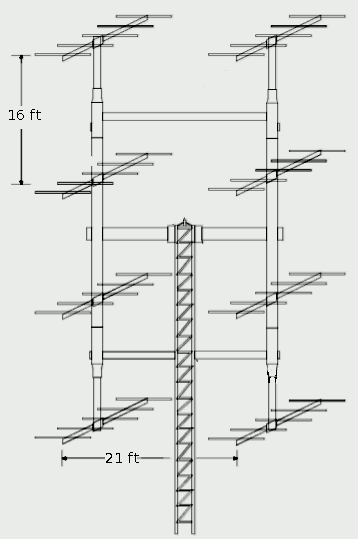
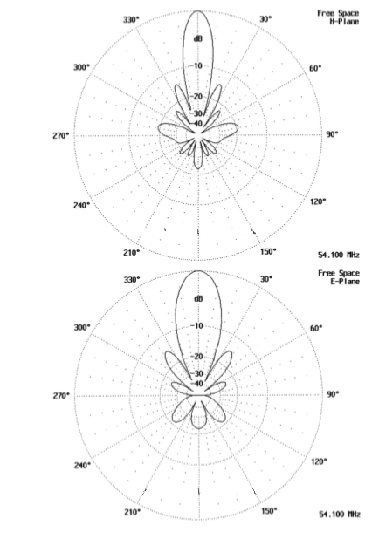
Left: Concept drawing for high-gain 54.1 MHz transmission antenna. Estimated forward gain is 20 dBi (factor of 100 over isotropic).
Right: Vertical (top) and Horizontal (bottom) transmission pattern for high-gain antenna.
5.2 Receiver Stations
A radar receiving station will be composed of array of four two-polarization log-periodic antennas (to detect wide-bandwidth signals with uniform gain), associated electronics and a host computer. The first receiver station to be deployed is co-located with and tethered to the Long Ridge fluorescence detector station. At later stages, our goal is to have several receiving station that are autonomous, distributed over a wide area, and connected to a fusion center through a local area network (LAN). The autonomous stations and the fusion center are envisioned as the prototype of a large-scale radar observatory. They will make use of solar power and a LAN. Receivers, computers and ancillary electronics will be housed in a radio hut that should be thermally insulated due to large swings in temperature in Utah's West Desert.
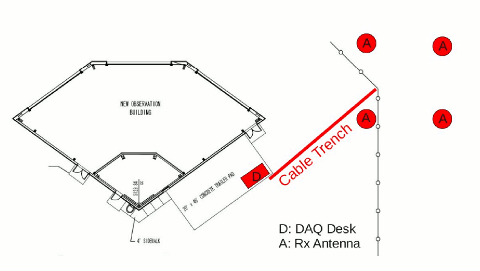
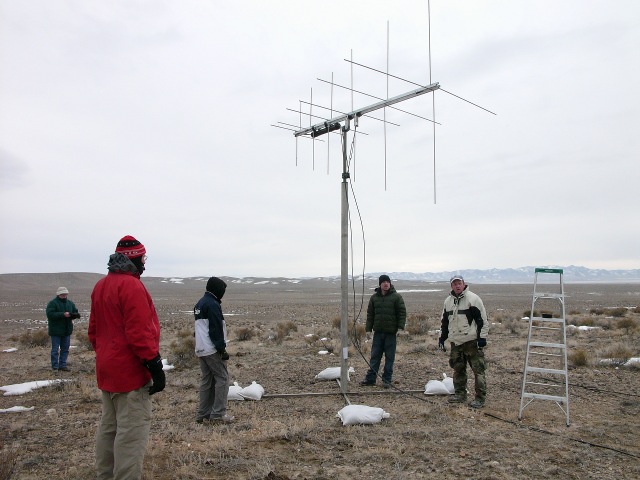
Left: Plan view of Long Ridge receive station, showing location of four TARA log-periodic receiver antennas relative to Long Ridge fluorescence detector.
Right: Photo of team standing by recently erected receiver antenna.
A crucial component to the execution of this project - and the key to dealing with the large Doppler excursions in frequency - is a flexible radio receiver to (1) receive the reflected signals from the air showers, (2) identify the occurrence of each air shower and capture the corresponding signal samples, and (3) store the captured signal in a host computer. To implement a radio that can be adapted to these requirements, we are developing a software-based radio (often called software defined radio --- SDR). We plan to use a FlexRIO National Instrument FPGA board and two front-end four-channel digitizers with a sampling rate of 250 MHz. This sampling rate is sufficient to capture the air shower chirp signals whose frequency can be as high as 80 or 90 MHz. We are making use of a large Vertex-5 FPGA module and 512 MB of RAM on the FlexRIO to develop a high-performance chirp detector/processor on the board.
The figure below depicts a block diagram of the SDR-based receiver that we are developing for the TARA receiver station. The received signals from 4 antennas (horizontal and vertical polarization, hence 8 signals in all) are sampled and passed to the FlexRIO FPGA board. A chirp signal analysis algorithm (implemented on the Vertex-5 FPGA) is then performed to identify the (possible) presence of a chirp spectrum in the sampled signals. If a chirp is identified, a fixed window of, say, 100 microseconds of the captured signal is passed to the host computer for storage. Using this approach, we are assured that only those portions of the received signal that are likely to contain reflections from air showers are stored. This reduces our storage needs from a prohibitive size to a very manageable size. Without getting into details here, we only note that without such intelligent mechanism our storage need per 24 hours would be in the order of a few tens of terabytes. We will reduce this number to less than 100 megabytes; a reduction factor in the order of 1/100,000.
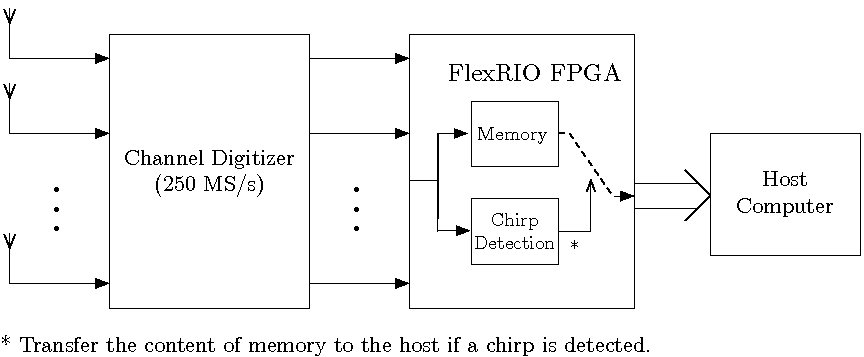
Block diagram of the radar receiver.
5.3 Plan of Analysis
The first analysis goal of the project will be to identify a set of events in which a radar transient of the appropriate frequency is coincident in time, and has a pointing direction consistent with a reconstructed TA Surface Detector (SD) event. We will start by generating a list of SD event times, then hand-scan the radar data stream. This will enable us to establish criteria for a pattern recognition program, both for the automatic matching of radar and SD events and for online filtering. Online filtering of the radar data stream will be required in order to reduce the output to manageable levels over the long term.
Once a sample of coincidences is obtained, we will want to compare the received power with predictions, as a function of energy and airshower geometry. We will quantify and fine-tune angular and timing resolutions, and finally work to understand airshower energy estimation within the radar technique.
6 The Future
If TARA proves the bistatic radar technique successful, we aim to one day deploy a remote-sensing radar array covering an area substantially larger than existing cosmic ray observatories. Undeveloped western Utah is the ideal place for deployment of such an array. As shown in the Figure, the ample open space surrounding the 800 square kilometer Telescope Array observatory could be used as the site of a radar array with tens or hundreds of times the cosmic ray aperture.
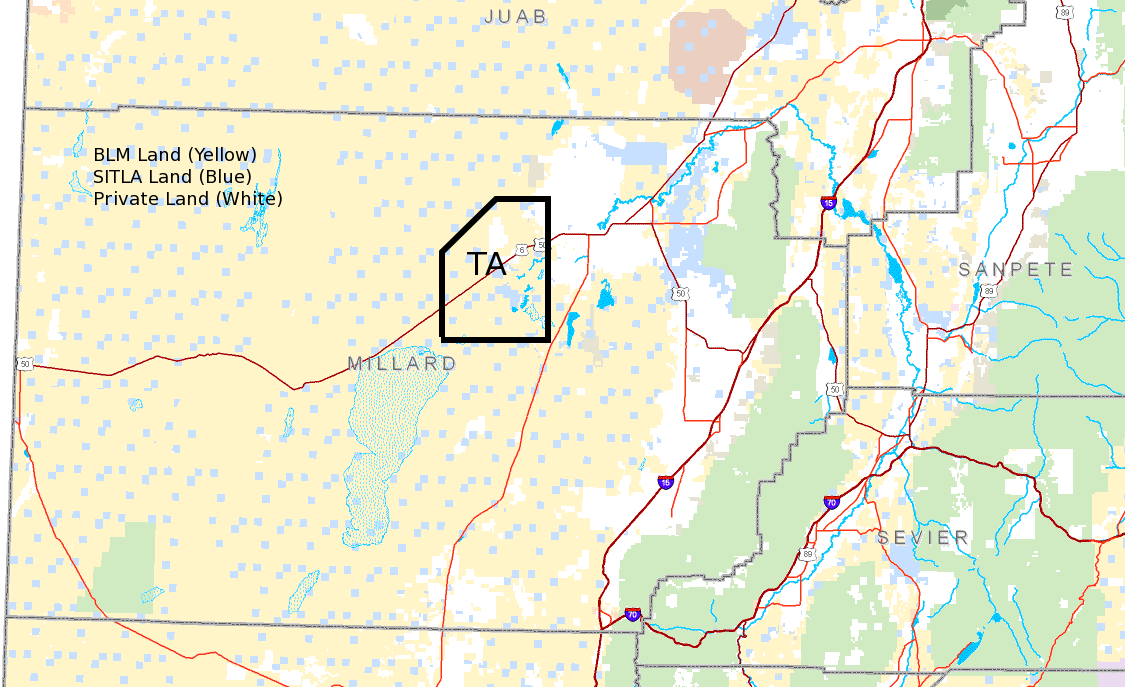
Map of Millard County, Utah and surrounding areas. Also shown is the location and size of the existing 800 square kilometer Telescope Array Observatory. Expansion of the TARA radar array into public lands currently run by the BLM and SITLA would facilitate the creation of the largest aperture - by a large factor - cosmic ray observatory ever deployed.
BIBLIOGRAPHY
- R.U. Abbasi et al., Phys. Rev. Lett. 104 161101 (2010).
- J. Belz et al., Astropart. Phys. V25 57 (2006).
- P.M.S. Blackett and A.C.B. Lovell, Proc. Roy. Soc. Volume A177 183 (1940).
- R. H. Brown, A.C.B. Lovell, The Exploration of Space by Radio, Wiley, New York (1962).
- K.G. Budden, The Propagation of Radio Waves, Cambridge University Press (1985).
- J.W. Crispin and A.L. Maffett, Proc. IEEE 53 833 (1965).
- T.K. Gaisser and A.M. Hillas, Proc. 15th ICRC, Plovdiv, Bulgaria 8 353 (1977)
- P.W. Gorham, Astropart. Phys. V15 177 (2001).
- J.S. Greenhow, Proc. Phys. Soc. Volume B65 169 (1952).
- K. Greisen, in J.G. Wilson (Editor) Prog. Cosmic Ray Physics, Vol III, North Holland, Amsterdam (1965).
- D. Heck et al., CORSIKA: A Monte Carlo Code to Simulate Extensive Air Showers, Forschungzentrum Karlsruhe, Wissenschaftliche Berichte FZKA 6019 (1998).
- W. Heitler, The Quantum Theory of Radiation (Oxford University Press, 1954).
- K. Kamata and J. Nishimura, Suppl. Progr. Theoret. Phys. 6 93 (1958)
- A.C.B. Lovell and J.A. Clegg, Proc. Phys. Soc. V60 491 (1948).
- A.C.B. Lovell, Notes Rec. R. Soc. Lond. 47 119 (1993).
- J. Matthews, Astropart. Phys. V22 387 (2005).
- C. Riviere (CODALEMA collaboration), Proc. 31st ICRC, Lodz, Poland (2009).
- F. Schroeder and S. Nehls (LOPES collaboration), Proc. 31st ICRC, Lodz, Poland (2009).
- K. Singh (LOFAR collaboration), Proc. 31st ICRC, Lodz, Poland (2009).
- K. Suga, Proc. Fifth Interamerican Seminar on Cosmic Rays, V2 (1962).
- D. Underwood, IEEE Conference Proceedings, Radar Conference (2008). http://ieeexplore.ieee.org archive 04721089.
- R.J. Vidmar, IEEE Trans. on Plasma Science 18 733 (1990).
Back to TARA Homepage